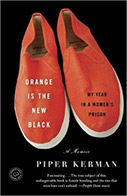Orange is the New Black: My Year in a Women’s Prison
 Author: Piper Kerman
Author: Piper Kerman
Publisher: New York: Spiegel & Grau, 2010. 320p.
Reviewer: Bonita M. Veysey | July 2013
Orange is the New Black based upon Piper Kerman’s thirteen-month experience at the federal prison camp in Danbury, CT is a great read. Written as a memoir, Kerman balances facts and observations with an easy style of candid intimacy. This is not the be all and end all of the prison experience, but rather one woman’s journey through a year of uncertainty, boredom and repeated humiliation as well as a year of learning, revelation, tactics of doing time, and finding friendship and forgiveness in unlikely places.
The federal prison camp is a unique correctional environment. The federal Bureau of Prisons (BOP) operates several types of facilities that house inmates of various custody levels. Danbury is one of seven facilities that house women, and it has both a Federal Prison Camp (FPC) that houses only minimum-security inmates and a Federal Correctional Institution (FCI) that houses women at higher security levels (as well as operates the Residential Drug Abuse Treatment Program). FPC’s have “dormitory housing, a relatively low staff-to-inmate ratio, and limited or no perimeter fencing.”1 At the present, there are 177,283 inmates in BOP facilities, 6.5 percent of whom are female. The average age is 39, 59% are White and 37% are Black, while 35% designate their ethnicity as “Hispanic.” Only 73% of federal inmates are US citizens. The largest groups of non-citizens come from Mexico, Colombia, Cuba and the Dominican Republic. Approximately 30% are serving sentences of 3 to 5 years or less. Nearly half are serving time for drug offenses.2
Federal prisoners are different from inmates in state prisons. Documented in a 2000 U.S. General Accounting Office report, in comparison to state prisoners, federal inmates were more likely to be better educated, White, to come from stable families, to be less likely to have been incarcerated previously, and were more likely to be serving a sentence on a drug conviction.3
Counter to the impressions of violent prison life gleaned from movies and quasi-documentaries, Kerman’s story reveals a group of women who are kind and supportive to newcomers, protective of friends, and crafty in finding ways to humanize their environment. This is not to say that each and every woman was someone you might want to have as a neighbor. Some were violent and/or out of control; some were out to scam the system or anyone who might seem vulnerable. She does not deny this. In fact, Kerman often points out those who were difficult. But this is the thing… drugs, poverty, lack of education, violence… in fact all the things from which Kerman’s privileged life protected her, were abundantly evident among her prison peers.
The women at the Danbury camp came from vastly different backgrounds. Their negotiation of prison life also varied from the poise and acceptance of the older nun to those who fought every step of the way. Kerman describes the difficulty many women faced in accepting their life at the camp. “I saw young women who had been running wild in poverty most of their lives rail against authority, and middle-aged, middle-class women who were aghast to find themselves living among people they thought were beneath them” (p. 124).
In some ways, the book is most informative about life in the camp by what Kerman does not say. She acknowledges that her blond hair, blue eyes, and a Smith College education make her stand out. She repeatedly notes how many prison employees ask her, “What is a nice girl like you doing here?” This observation in and of itself makes a bold statement about the others. They are not like Kerman. They should be in prison. This observation led me to consider two things: blameworthiness, and who deserves punishment.
Kerman was indicted on federal conspiracy charges related to the intent to transport drugs into the U.S., but was convicted of money laundering in a plea deal. The nature of the conviction, however, had little to do with Kerman’s personal sense of guilt. In the beginning of the book, she clearly states that she was, “entranced by the illicit adventure” (p. 8) and, at the same time, acknowledges that, “the reality of drugs felt like a complete abstraction to me. I didn’t know anyone who used heroin; and the suffering of addiction was not something I thought about” (p. 8). When describing her initial reactions, Kerman’s guilt lay in her poor choices, the shame and embarrassment she felt when her past became public, and the suffering she caused to her fiancé, family and close friends. Over time she comes to understand that her participation in drug distribution activities contributed to someone else’s addiction and the consequent devastation to families and communities. While Kerman reflects, “EVERYBODY WHO loved me wanted me to be innocent — tricked, duped, all unawares,” (p.278) and thus not really to blame, in the end she accepts responsibility for her actions and the larger unintended consequences to others of her behavior.
In virtually all aspects of her life, Kerman is a conventional member of American society. Among all the stereotypes of criminals, she is the least likely to be associated with crime. This seems to be what underlies the confusion of many corrections staff. She simply doesn’t fit the mold. Kerman’s reports of others’ reactions (e.g., corrections and court personnel and family and friends) seem to affirm that she deserves her sentence by law, but not by social convention. She is not a risk to public safety nor is she a drain on public funds. She has vast resources of social capital. The inequities between Kerman’s place in the world and the other convicts are profound.
Ironically, because of her status and resources, Kerman can afford to acknowledge her past. Unlike others, her conviction status does not create insurmountable barriers to a successful life. Not only can she make her past public, she has been able to publish a successful memoir. It is a quaint and familiar narrative; good girl loses her way, is punished and learns from her mistakes, and returns to society as a better person. Like The Prince and the Pauper, Kerman trades her life in affluent America, albeit involuntarily, to walk on unfamiliar ground, and thereby, to understand how others live. Importantly, she has been able to communicate clearly and effectively this understanding.
Her education and experience give Kerman an objective distance with which to view her and the other women’s prison experience. This objective distance, however, is precisely how she differs from so many others. This experience is more of an interruption in an otherwise successful life. One can afford to be objective when the experience is so bounded. Unlike so many others, she has a good job, a fiancé, and a loving family and community of friends awaiting her return. Not to underestimate the distress and pain she endured during her 13-month stay, but Kerman was one of a very lucky few who could simply pick up life where she left off.
I highly recommend this book. At a minimum, it gives the reader a sense of life in a minimum-security prison and a positive view of incarcerated women. A closer read will challenge the reader’s own assumptions about the deserving and the undeserving; the meaning of guilt and reform; and the tactics of punishment above and beyond loss of freedom.
Bonita M. Veysey, Ph.D., Rutgers University, School of Criminal Justice
2 U.S. Department of Justice, Bureau of Prisons. (2012). Quick Facts. www.bop.gov/news/quick.jsp#1. Accessed August, 2012.
3 U.S. General Accounting Office. (2000). State and Federal Prisoners: Profiles of Inmate Characteristics in 1991 and 1997. Washington, D.C.: U.S. General Accounting Office.


